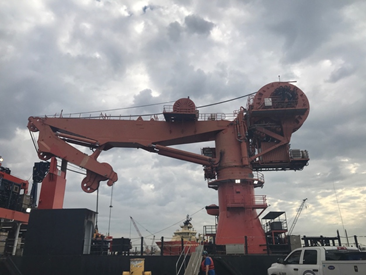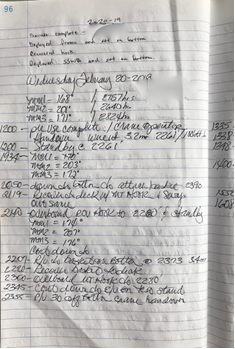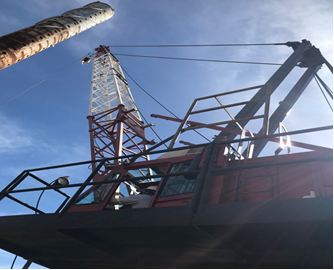The Drill Down, Issue #17: Crane Record Book
 Introduction
Introduction
Lifting devices, such as cranes, are integral to sustaining most operations on Offshore Supply Vessels (OSVs). Cranes, found on all OSVs such as liftboats and subsea construction vessels, must be designed and equipped to transfer various loads, such as drill pipe, hoses, and personnel.
Documentation is a crucial element of a safely operated and proactively managed crane. Most of the required items for crane documentation are found in the ship’s crane record book.
This issue of the Drill Down explores crane record book applicability and required entries.
Definitions & Applicability
 46 CFR 125.160 in Subchapter L defines a crane as “…a revolving, gantry-mounted, or other type of fixed lifting device used for lifting or moving equipment or supplies. It does not include material handling equipment used for general ship's service, such as lifeboat davits, chain falls, come-alongs, or the like.”
46 CFR 125.160 in Subchapter L defines a crane as “…a revolving, gantry-mounted, or other type of fixed lifting device used for lifting or moving equipment or supplies. It does not include material handling equipment used for general ship's service, such as lifeboat davits, chain falls, come-alongs, or the like.”
46 CFR 126.130 further requires that cranes installed onboard meet specific requirements regarding cranes as found in 46 CFR Parts 107, 108 and 109.
46 CFR § 125.160 in Subchapter L defines a crane as "…a revolving, gantry-mounted, or other type of fixed lifting device used for lifting or moving equipment or supplies. It does not include material handling equipment used for general ship's service, such as lifeboat davits, chain falls, come-alongs, or the like."
46 CFR § 126.130 further requires that cranes installed onboard meet specific requirements regarding cranes as found in parts 107, 108, and 109.
COMDTINST 16000.76, 6.B.13 states that pedestal-mounted cranes on OSVs, having a lifting capacity less than five net tons (10,000 lbs) and used for special purposes (e.g. lifting fuel hoses or handling ships stores) do not have to meet API Recommended Practice 2D standards, but rather should meet manufacturer’s recommendations, and are therefore exempt from crane record book requirements. However, this does not prohibit the OCMI or the attending Marine Inspector from inspecting the crane for safety and proper functionality, nor does it relieve the owner/operator from the obligation of maintaining and safely operating the crane.
Crane Record Book
 46 CFR 109.437 contains the guidelines for the crane record book contents, including information required by Section 3 of the American Petroleum Institute (API) Recommended Practice (RP) for Operation and Maintenance of Offshore Cranes, API RP 2D, First Edition (October 1972) with supplement 1.
46 CFR 109.437 contains the guidelines for the crane record book contents, including information required by Section 3 of the American Petroleum Institute (API) Recommended Practice (RP) for Operation and Maintenance of Offshore Cranes, API RP 2D, First Edition (October 1972) with supplement 1.
API RP 2D has been updated several times since 1972, but the First Edition (with supplement 1) is the only edition incorporated by reference in the CFR; other editions should not be used to satisfy Coast Guard inspection requirements.
If a crane has been decommissioned but remains installed on the vessel, the decommissioned crane’s information may not be present in the crane record book. In this case, the attending Marine Inspector should verify supporting evidence that the crane is no longer in use.
The crane record book shall have copies of the crane’s data plate and reeving chart for each crane in use.
Additionally, the crane record book will have the information required by API RP 2D Section 3 “Inspection, Testing, and Maintenance”, requiring the following:
- Inspection dates, including detailed descriptions of all required inspections;
- A description of any replaced crane components;
- The dates of any failures to the crane;
- Dates and descriptions of repairs done to any part of the crane
46 CFR 109.437(e) through (h) has requirements similar to API RP 2D Section 3:
- Dates and results of rated load tests;
- Replacement or renewal of wire rope, hooks and other load components;
- Date and description of each failure of the crane, or any component or safety feature;
- Date and description of each repair to the crane structure, boom, or equipment.
The documentation requirements of API RP 2D Section 3 and 46 CFR 109.437(e) through (h) cover a wide array of activities and may be presented to the Marine Inspector in various formats, including third-party servicing reports, company generated use or inspection reports, and notes related to the status of the crane and its associated components.
The crane record book may be entirely electronic, paper, or a combination of both (see figure 1 for a crane record book excerpt). The CFR, API standards, and Coast Guard policy is not prescriptive with the crane record book format. Most importantly, the required information should be organized, actively managed and available for inspection at all times.
 Conclusion
Conclusion
Crane management, including record keeping, training, and maintenance, is the responsibility of the vessel master or person in charge.
As with most vessel records, there should be a consistent timeline of events with no gaps. For example, the crane record book should track an identified faulty component’s cycle, subsequent servicing or repair, testing, and notation of the crane’s operational status.
The crane record book should be cohesive across all the sources of information such as third-party servicing reports, testing, inspection, and usage logs. If the required information is missing, outdated, or otherwise incomplete, there may be clear grounds to expand the inspection scope.
References
The following publications are available for CG Marine Inspectors through API’s Reading Room website (https://publications.api.org/) under the “Exploration and Production” section:
- American Petroleum Institute (API) Recommended Practice (RP) 2D – Operation & Maintenance of Offshore Cranes, First Edition, October 1972
- American Petroleum Institute (API) Spec. 2C – Specification for Offshore Cranes, Second Edition, February 1972
Published 11Feb2021. Revision 1, 25Apr2023.